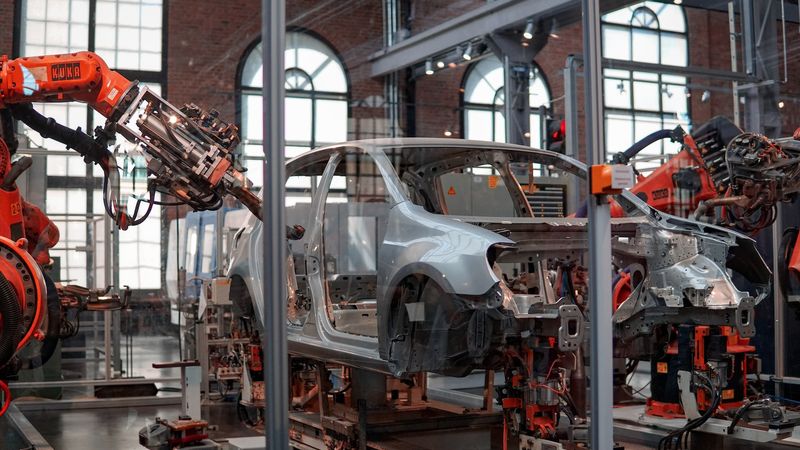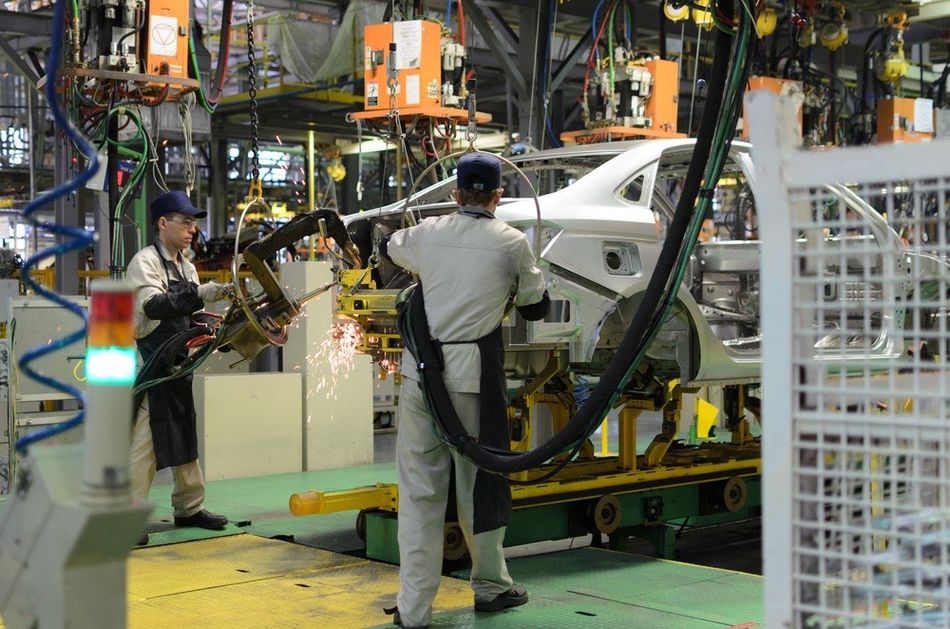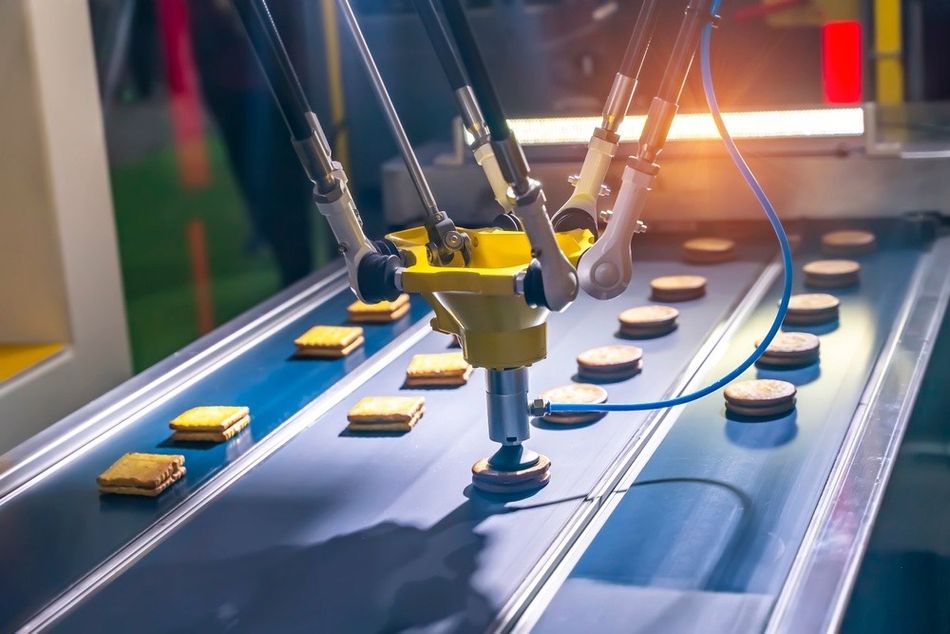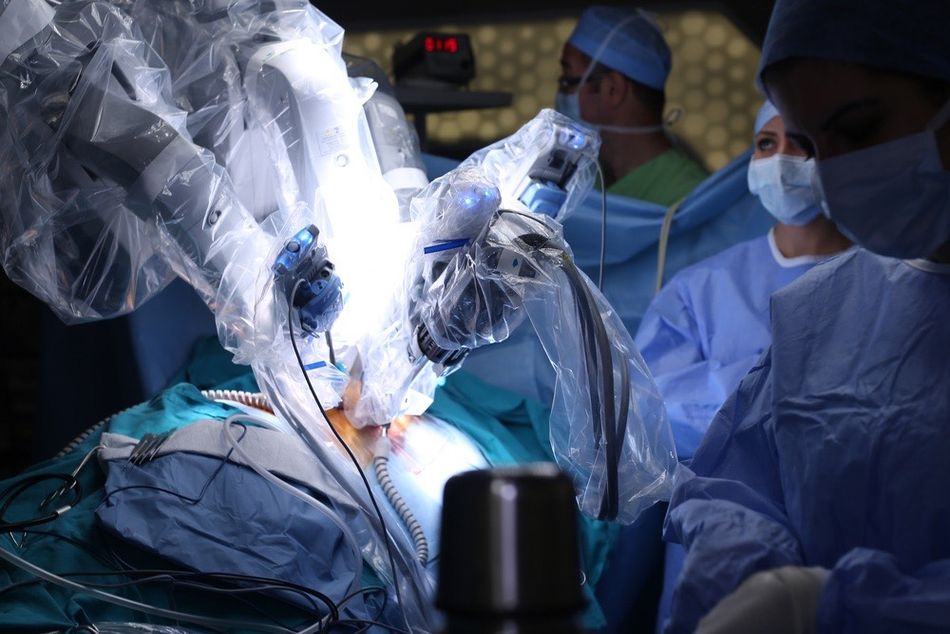7 Types of Industrial Robots: Advantages, Disadvantages, Applications, and More
Robots have helped us solve some of the most challenging problems in the industries. They come in all shapes and sizes and take care of many repetitive and hazardous tasks. Based on their design, they can be classified into cartesian, articulated, cylindrical, delta, polar, SCARA, and cobots.

Automated car assembly with industrial robots
Introduction
Industrial robots are the unsung heroes of modern manufacturing, transforming the way products are created and assembled. These advanced machines have become essential tools in industries worldwide, offering unmatched precision, speed, and consistency. As automation continues to reshape engineering and manufacturing, understanding the various types of industrial robots is crucial for professionals looking to stay ahead of the curve.
This article will provide an in-depth look at seven distinct types of industrial robots, exploring their unique features, technical specifications, and cutting-edge applications. From the versatile articulated robots to the high-speed Delta robots, and from the precise Cartesian robots to the collaborative robots working alongside humans, we will delve into the world of industrial robotics and discover how these machines are revolutionizing manufacturing processes.
What are Industrial Robots?
Industrial robots are automated machines that perform repetitive, hazardous, and tough tasks more quickly, efficiently, and precisely than humans. They reduce human dependency and boost the productivity and capacity of the process they are a part of.
Though the idea of robots dates back to ancient times, significant advancements in robotics emerged in the 19th century with new mechanical, electrical, and electronic technologies. As electromechanical systems advanced, the integration of information and communication technology propelled robots to new levels of capability. Today, robots are ubiquitous across industries, playing vital roles in various aspects of our lives.
Recommended Reading: A History of Industrial Robots
At the heart of robotic engineering lie three pivotal principles:
Autonomy
Autonomy in industrial robots is characterized by their capacity to make independent decisions based on sensory data and programmed instructions. This self-governing nature is bolstered by recent strides in robotics software, which now offers more user-friendly programming environments and better integration with factory systems for data sharing and real-time performance analytics.
Programmability
Programmability grants robots the versatility to perform a variety of tasks, as engineers use specialized programming languages to dictate robot actions and adapt to new production demands.
Automation
Automation enables robots to carry out tasks with minimal human oversight, leading to enhanced efficiency and precision in production lines.
Essential Components of Industrial Robots
A typical industrial robot is made of the following functional elements:
Controller: It provides the robot with the memory and processing power necessary for operation. The robot’s controller acts as the brain of the whole control system.
Sensors: Robots use sensors to gather data from their surrounding environments. Sensors are the eyes and ears of the robot.
Drive and Power Source: A robot can use electrical, pneumatic, hydraulic, or any other drive to draw and convert the power required for its operation.
Robotic Arm: Designed to mimic a human arm, robotic arms are structures made of several segments connected by joints/linkages. The joints can be programmed to move in the desired direction.
End of the Arm Tooling (EOAT)/End Effectors: EOATs are customized equipment/actuators connected at the end of a robotic arm used to perform specific operations such as welding, material handling, painting, assembly, etc. Some industrial robots support the swapping of EOATs to let them perform different operations.
Machine Learning: ML Algorithms are now an essential part of industrial robots, transforming vast datasets into actionable intelligence, which allow robots to learn from experiences, hone their decision-making, and adjust to new tasks with improved efficiency. Therefore, modern robots can increasingly perform complex operations with or without human assistance.
Types Industrial Robots
Articulated Robots
Articulated robots are the most versatile and widely used type of industrial robot. They consist of a series of rotary joints powered by servo motors. These joints mimic the flexibility of a human arm., and are incredibly fast. Typically, articulated robots can have four to six axes of motion, allowing them to navigate tight spaces and perform complex tasks.
Feature | Description |
Axes of Motion | 4 to 6 rotary joints, mimicking human arm flexibility |
Payload Capacity | Varies from a few kilograms to several hundred kilograms |
Reach | Less than a meter to several meters, depending on the model |
Speed | Some models can exceed 10 meters per second |
Precision | Repeatability of less than 0.1 millimeters |
Control Systems | Teach pendants and offline programming software |
Programming Languages | RAPID, KRL, KAREL |
Articulated Robot Applications: The automotive industry heavily relies on articulated robots for spot welding, sealing, and painting applications, while the aerospace sector employs them for drilling, riveting, and composite layup tasks.
The major drawback of Articulated Robots is their design complexity. The rotary joints can be more complicated and time-consuming for their programming and are more expensive.
SCARA Robots
SCARA (Selective Compliance Articulated Robot Arm) robots, known for their speed, precision, and efficiency, are ideal for tasks within a single plane. With a unique parallel-axis joint layout consisting of two rotary joints, a linear joint, and sophisticated control software, SCARA robots excel at fast, repeatable motions in the horizontal plane. Moreover, path planning, obstacle avoidance, and vision system integration enhance their performance and adaptability.
The selective compliance of SCARA robots, achieved through their joint configuration, allows for high rigidity in the vertical direction and flexibility in the horizontal plane. This makes them perfect for tasks like inserting parts or performing operations that require a degree of flexibility.
Feature | Description |
Joint Configuration | Parallel-axis layout: 2 rotary joints, 1 linear joint |
Workspace | Single plane, typically horizontal |
Speed | Up to 120 picks/minute |
Precision | Repeatability: ±0.01 to ±0.03 mm |
Control | Advanced servo motors, encoders, path planning, obstacle avoidance, vision integration |
SCARA Robot Applications: These SCARA robots are extensively used for PCB assembly, SMD placement, soldering, and inspection. The automotive sector also employs SCARA robots for tasks such as engine and transmission assembly, and placement of small parts.
The major drawback of SCARA robots is their payload. They are only suitable for light/moderately heavy loads weighing up to 10 kg making them unsuitable for working with heavy objects.
Cartesian Robots
Cartesian robots, also known as linear or gantry robots, feature axes of motion arranged in a rectangular coordinate system (X, Y, and Z). Each axis, driven by a linear actuator such as a ball screw or linear motor, allows for precise and independent movement.
The motion of the axes is controlled by a computer numerical control (CNC) system, which coordinates the actuators to achieve the desired position and orientation of the end effector. This enables Cartesian robots to achieve high precision and repeatability.
Feature | Description |
Axes | X, Y, Z linear axes (rectangular coordinate system) |
Actuators | Ball screw, linear motor |
Control | CNC system |
Precision | Positioning: ±0.02 to ±0.05 mm, Repeatability: ±0.01 to ±0.03 mm |
Load Capacity | Few kg to several hundred kg (size-dependent) |
Programming | G-code (CNC), C++, Python |
Cartesian Robot Applications: Thanks to their precision and repeatability, Cartesian robots are suitable for applications requiring accurate positioning and repetitive tasks. In electronics, they are used for pick-and-place operations, PCB assembly, and wire bonding. 3D printing heavily relies on Cartesian robots to control print head movement and material deposition. Other applications include dispensing, welding, cutting, and inspection.
Cartesian robots take up more space and often have a limited speed. Moreover, since they are designed for pre-programmed movements, they are less flexible than some of their counterparts.
Cylindrical Robots
Cylindrical robots are known for their unique structure and movement capabilities, consisting of a base, a vertical column, and a robotic arm extending from the column. The arm moves linearly along the vertical column, while the column rotates around the base, and the arm extends and retracts, creating a cylindrical work envelope.
This combination of rotational and linear motion enables cylindrical robots to perform a wide range of tasks with high accuracy and repeatability. Servo motors and encoders provide precise positioning and motion control, while advanced features like path planning, obstacle avoidance, and force control enhance their performance in complex tasks.
Feature | Description |
Structure | Base, vertical column, and robotic arm |
Motion | Rotational (θ axis), linear (Z axis), and arm extension/retraction (R axis) |
Work Envelope | Cylindrical |
Control | Servo motors, encoders, path planning, obstacle avoidance, force control |
Programming | RAPID, KRL, KAREL, teach pendants, graphical user interfaces (GUIs) |
Cylindrical Robot Applications: The unique structure and movement capabilities of cylindrical robots make them ideal for assembly operations, handling tasks, and manipulation applications such as tightening screws and applying adhesives. Likewise, they serve pick and place operations, manipulation, palletization, and packaging applications.
The only drawback in cylindrical robots is their captured space. They require a considerable floor space, which makes them a less preferred option in space-constrained environments.
Polar Robots
Polar robots are also called ‘Spherical Robots’ and they feature a combination of a rotational joint pair and a linear joint. Their operation creates a spherical working space. These robots can enhance their reach when integrated with a suitably long linear arm. The first-ever industrial robot, Unimate, was a polar robot.
Feature | Description |
Structure | Two rotational joints for vertical and horizontal rotation, one linear joint for robotic arm extension. |
Load Capacity | Several hundred kilograms |
Work Envelope | Spherical |
Programming | RAPID, KAREL, KRL, GUIs |
Polar Robot Applications: These robots are extensively used for injection moulding, spot welding, and arc welding.
One of the drawbacks of Polar Robots is their limited access because of a spherical workplace. Moreover, they are more complex and less cost-effective than articulated robots which also possess a spherical work envelope.
Collaborative Robots
Collaborative Robots are also called Cobots, mainly because of their ability to work alongside humans. They are quite similar to polar robots and can perform tasks on an assembly line. Typically, Cobots feature built-in sensors to detect obstacles and humans, making them safe for collaborative work environments.
Feature | Description |
Structure | Rotational and linear joints |
Load Capacity | Few grams to several hundred kilograms |
Work Envelope | Varies according to application |
Programming | Ruby, GUIs, Touch interfaces |

Collaborative Robot Applications: While Cobots are designed to assist humans, their applications are different from other conventional robots. They are mainly designed to assist in a safe environment while most robots are used for repetitive automated applications.
Suggested Reading: Cobots vs Robots: Understanding the Key Differences and Applications
Since collaborative robots are designed for safe working environments, they are understandably slow and have limited accessibility. Moreover, the safety features require the integration of more sensors, making them more expensive than the other types.
Delta Robots
Delta robots are industrial robots made on a rigid triangular frame. The frame is mounted above the working area, with each arm hosting a high-torque servo motor. The motor shaft is connected to an arm called the “bicep, “ which extends in the perpendicular direction of the motor’s axis of rotation. The other end of the bicep is connected to rods arranged in a parallelogram shape. Depending on the application, the parallelogram-shaped rods can be connected to various EOAT manipulators.
Feature | Description |
Structure | Triangular frame |
Load Capacity | Few kilograms |
Work Envelope | Cubical |
Programming | CodeSYS, TwinCAT, GUIs |
Delta Robot Applications: Delta robots are primarily used in repetitive high-speed placement applications. They are also used with Computer Vision systems to reduce human dependency.
Since Delta robots work in a confined space, they are suited for low-payload applications. Their structure doesn’t support the lifting of heavy objects.
Engineering Marvels: The Impact Industrial Robots Applications
Automotive Manufacturing
Articulated robots have become a game-changer in automotive manufacturing. These versatile robots can weld, paint, and assemble components with remarkable accuracy, significantly reducing cycle times and improving product quality. By taking over hazardous and repetitive tasks, articulated robots have also enhanced worker safety in automotive plants.
Food Industry
According to a case study, Delta Robots programmed with advanced algorithms helped a company in packaging delicate food items, while maintaining product integrity. The use of machine vision systems allowed the robots to accurately locate and orient the products, ensuring consistent packaging quality.

Robotic Concierges
Robotic concierges are being deployed in hotels to greet guests, provide information, and deliver items to rooms. By using natural language processing and machine learning algorithms, these robots can understand and respond to guest queries. They navigate autonomously through the hotel using advanced sensors and mapping technology, avoiding obstacles and interacting safely with humans, providing a seamless and efficient service experience.
Similarly, Robotic chefs can prepare meals using computer vision and machine learning algorithms to identify ingredients, measure quantities, and execute recipes with unrivalled precision. Working alongside human chefs, these robotic assistants handle repetitive tasks such as chopping and stirring, allowing their human counterparts to focus on the creative aspects of cooking and elevating the culinary experience.
Surgical Systems and Healthcare
The da Vinci Surgical System, a robotic platform, empowers surgeons to perform complex procedures with unparalleled accuracy and flexibility. The system's robotic arms, controlled from a console, hold miniaturized surgical instruments that move with scaled and filtered precision, eliminating hand tremors. It features a magnified, high-definition 3D view of the surgical site, which enhances visualization and control, enabling surgeons to make precise incisions and manipulate tissue.

Likewise, Robotic exoskeletons provide mobility assistance for patients with impairments. These wearable robots use sensors to detect the user's movements and provide motorized support for walking and other activities. The control systems of these exoskeletons often incorporate machine learning algorithms that adapt to the user's unique gait patterns, providing personalized and seamless assistance.
Agriculture Sector
Autonomous tractors, equipped with advanced GPS and sensor systems, can plant seeds and apply fertilizers with unparalleled precision, minimizing waste and maximizing efficiency. These tractors rely on sophisticated navigation algorithms to follow pre-programmed routes and navigate around obstacles in the field, ensuring optimal coverage and performance. Robotic harvesters are transforming the way delicate fruits and vegetables, such as strawberries and lettuce, are picked. These robots employ computer vision and machine learning algorithms to identify ripe produce and gently grasp and cut it without causing damage. With the ability to work tirelessly around the clock, these robotic harvesters significantly boost productivity and reduce labour costs.
Further Reading: Industry 4.0 Deep Dive. Part 4: Evolving Industrial Robots
Challenges and Ethical Considerations with Industrial Robots
Addressing the Technical Challenges
The deployment of industrial robots in various sectors comes with several technical challenges that must be addressed to ensure smooth integration and optimal performance.
Integration with Existing Systems: One of the primary challenges is the complexity of integrating robotic systems with existing infrastructure and processes. This often requires significant modifications to the physical layout of the workspace, as well as changes to the software and control systems to enable seamless communication between the robots and other equipment.
To address these challenges, there is a growing focus on developing more modular and flexible systems that can be easily integrated into existing workflows. Plug-and-play robotic solutions, which come with pre-configured hardware and software, are becoming increasingly popular as they reduce the time and effort required for integration. These systems often use standardized communication protocols and interfaces, making it easier to connect them with other equipment and control systems.
Maintenance: The maintenance and upkeep of robotic systems is another significant challenge. Industrial robots are complex machines with numerous moving parts and sensitive electronic components. Therefore, regular maintenance, including lubrication, calibration, and replacement of worn parts, is essential to ensure reliable operation and minimize downtime. This requires skilled technicians trained in the specific maintenance requirements of each robotic system.
Several predictive maintenance techniques are being developed to monitor the health of robotic systems in real time and identify potential issues before they cause failures. These techniques use sensors and machine learning algorithms to analyze data from the robots, such as vibration, temperature, and power consumption, to detect anomalies and predict when maintenance is required. This allows for proactive maintenance, reducing unplanned downtime and extending the lifespan of the robotic systems.
Recommended Reading: Overcoming Challenges in Industrial Robotics
Ethical and Safety Considerations
The increasing use of industrial robots in various sectors has raised important ethical and safety considerations that must be addressed to ensure responsible and safe deployment of these technologies:
Job displacement: The automation of tasks by robots raises concerns about job losses and the impact on the workforce, prompting questions about the responsibility of companies to retrain and support displaced workers.
Accountability and liability: Determining accountability and liability when robots malfunction or cause accidents can be challenging, as it may be unclear whether the robot manufacturer, software developer, or the company using the robot is responsible.
Privacy and data security: Industrial robots often collect and process vast amounts of sensitive data, making it crucial to ensure the privacy and security of this information to prevent unauthorized access or misuse.
To address these ethical concerns, companies and policymakers are developing guidelines and regulations for the responsible use of industrial robots, such as:
Conducting thorough risk assessments and impact studies to identify potential ethical issues and develop mitigation strategies before implementing robotic systems.
Providing training and support programs to help workers affected by automation transition to new roles or acquire new skills.
Establishing clear policies and procedures for data collection, storage, and use to protect privacy and ensure data security.
Ensuring the safety of human workers who interact with industrial robots is of utmost importance. Safety standards, such as ISO 10218, provide guidelines for the design, installation, and operation of industrial robots to minimize risks to human operators. Key technical measures in place for working with industrial robots include:
Safety-rated monitored stops: Control systems that monitor the robot's movements and can quickly stop the robot if a human enters its working envelope.
Collaborative robot design: Cobots featuring rounded edges, padded surfaces, and force-limiting sensors to minimize the risk of injury in case of contact with a human.
Safety sensors: Advanced sensors, such as vision systems and proximity sensors, used to detect the presence of humans and adjust the robot's behavior accordingly.
Advanced sensors and artificial intelligence (AI) play an increasingly important role in ensuring safe human-robot interactions:
Vision systems with deep learning algorithms can accurately detect and track human movements, enabling robots to anticipate and avoid potential collisions.
Tactile sensors and force control algorithms allow robots to sense and respond to contact with humans, adjusting their force and speed to prevent injury.
Machine learning algorithms can analyze data from multiple sensors to predict and prevent unsafe situations, such as detecting when a human is fatigued or distracted and adjusting the robot's behavior accordingly.
Despite these advancements, challenges and considerations that need to be addressed include:
Ensuring the reliability and robustness of safety systems, particularly in complex and dynamic environments.
Developing standardized testing and certification processes for collaborative robots and safety systems.
Addressing the potential for sensor failures or false positives that could lead to unexpected robot behavior.
Conclusion
The article delves into the diverse landscape of industrial robots, highlighting their transformative impact on engineering. From articulated to delta and Cartesian to collaborative robots, each type offers unique advantages in manufacturing processes. Integration of sensors, machine learning, and AI has bolstered robots' performance and safety, enabling them to tackle complex tasks and collaborate with humans.
Looking ahead, ongoing advancements in sensing, AI, and human-robot interaction promise even more capable systems, fostering innovation in manufacturing. Yet, the adoption of industrial robots brings challenges like integration, maintenance, and ethical considerations around job displacement and data privacy. By understanding robot types and advancements, engineers can harness these tools responsibly to drive growth and innovation in engineering, ensuring industrial robots remain central to manufacturing's future evolution.
FAQs: Unraveling Common Queries
What makes collaborative robots different from traditional industrial robots in terms of technology and programming?
Collaborative robots, or cobots, differ from traditional industrial robots in several key ways:
Safety features: Cobots are designed with built-in safety features, such as force-limiting sensors, rounded edges, and padded surfaces.Programming: Cobots often use more intuitive programming interfaces, such as hand-guiding or graphical user interfaces. Flexibility: Cobots are generally more flexible and adaptable than traditional industrial robots.
Payload and speed: Cobots typically have lower payload capacities and speeds compared to traditional industrial robots.
How are advancements in sensor technology and AI contributing to the safety and efficiency of industrial robots?
Sensor technology and AI contribute to industrial robotic evolution by enhancing data quality and improving its accuracy. As a result, the AI algorithms can update and upgrade with more accurate data and reduce operational errors. Likewise, the integration of sensors with AI also improves the understanding of human behaviours which can improve the operation of cobots in collaborative workspaces.
What are the technical criteria for selecting an industrial robot for a specific application, and how do they vary across different types of robots?
The technical criteria for robot selection focus on factors such as Payload capacity, reach and workspace envelope, Precision and repeatability, speed, degrees of freedom, and environment.
How can small-scale businesses or startups integrate industrial robots into their operations, considering technical and financial constraints?
Small-scale businesses and startups can integrate industrial robots into their operations by considering the following:
Identify suitable tasks: Identify tasks that are repetitive, time-consuming, or ergonomically challenging for human workers. These tasks are often the best candidates for robotic automation.
Consider collaborative robots: Cobots are generally more affordable and easier to implement than traditional industrial robots. They can work alongside human workers without the need for extensive safety barriers, making them suitable for smaller workspaces.
Opt for modular and flexible solutions: Look for robotic systems that are modular and flexible, allowing for easy redeployment and adaptation to different tasks. This can help maximize the return on investment and future-proof the automation setup.
Explore financing options: Consider leasing or financing options to spread the cost of the robotic system over time. Some robot manufacturers offer robot-as-a-service (RaaS) models, which provide access to robotic automation on a subscription basis.
Partner with system integrators: Work with experienced system integrators who can help assess the specific needs, recommend suitable robotic solutions, and provide support for integration and maintenance.
Invest in training: Provide training for employees to work effectively alongside robots and to maintain and troubleshoot the robotic systems. This can help ensure a smooth integration and long-term success of the robotic automation project.
References
Full article: Machine learning in manufacturing and industry 4.0 applications (tandfonline.com)
What Is a SCARA Robot? The Background and Benefits - RoboDK blog
Types of industrial robots and their different uses | HowToRobot
Polar Robots: Types, Applications & Advantages - Developed By Ghosted (svrobotics.us)
Table of Contents
IntroductionWhat are Industrial Robots?Autonomy ProgrammabilityAutomation Essential Components of Industrial RobotsTypes Industrial RobotsEngineering Marvels: The Impact Industrial Robots ApplicationsAutomotive ManufacturingFood IndustryRobotic ConciergesSurgical Systems and HealthcareAgriculture SectorChallenges and Ethical Considerations with Industrial RobotsAddressing the Technical ChallengesEthical and Safety ConsiderationsConclusionFAQs: Unraveling Common QueriesReferences